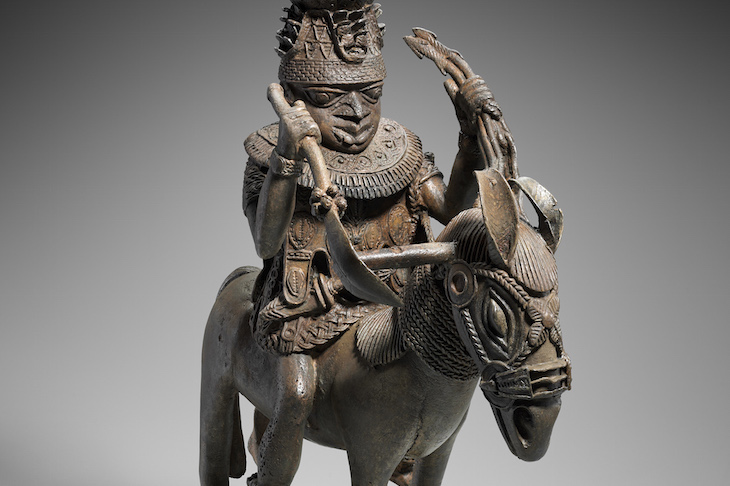In the Edo language, the verb sa-e-y-ama means ‘to remember’, but its literal translation is ‘to cast a motif in bronze’. At the court of Benin, art in bronze perpetuates memory; traditionally, the first commissions of every Benin king are sculptures in bronze and ivory for his father’s memorial altar. The great aesthetic and historical significance of these artworks to the people of Benin raises the question: who should be able to access and enjoy them? Since 2007, the Benin Dialogue Group, a consortium composed of the Nigerian National Commission for Museums and Monuments, delegates of the Oba (king) of Benin, and curators of African art at European museums, has been debating the future of Benin art held in Europe. It has recently determined that European institutions will loan important pieces on a rotating basis to Nigeria for a permanent display, at a museum purpose-built to display the art of Benin that will open in 2021.
The art of Benin entered European collections primarily as the result of the British occupation of Benin City in 1897 during the reign of Oba Ovonramwen (r. 1888–97). By August 1898, most of the ivory and bronze artworks seized by the British from the royal treasury had been sold in large public auctions. Felix von Luschan, a curator at the Berlin Ethnographic Museum, trying to explain his interest in the Benin Bronzes to an audience more familiar with European art, famously compared them to the work of a celebrated Italian Renaissance sculptor, stating, ‘Benvenuto Cellini could not have made a better cast himself, and no one has before or since, even to the present day. These bronzes stand even at the summit of what can be technically achieved.’ By 1901, nearly all of the bronzes had been swept into public and private collections in the United Kingdom, Germany and Austria. The Obas of Benin have been asking for their return for decades.
Casting in bronze – or more accurately, brass, bronze, and sometimes copper – began in Benin before the 13th century, and large-scale artworks were first commissioned under Oba Ewuare I (r. c. 1440-70s). Commemorative heads made for royal altars date back to the 16th century, if not earlier. From the 18th century onwards, artists carved scenes into the ivory tusks that had always surmounted the bronze heads, providing greater visual reference to the life’s work of the honoured Oba. Artists also cast sculptures of messengers, vanquished enemies, and foreign allies to celebrate the lives of departed kings through altar tableaux.
Head of an Oba (1550–1680), Edo peoples, Benin kingdom, Nigeria. Metropolitan Museum of Art, New York

In addition to art intended for memorial altars, there are also more than 850 reliefs that once sheathed the columns of the Oba’s audience court in Benin City. They were probably commissioned by Ewuare’s grandson, Oba Esigie (r. 1517–c. 1550), after a bruising civil war and a subsequent attempted invasion of Benin by the kingdom of Idah. The plaques depict the ideal relationship between a king and his court at a time of serious political division. Esigie’s son Orhogbua (r. c. 1550–70s), who likely completed the commission, may have added plaques that record the Idah war as well as religious rites, processions, battles, the payment of taxes, and other regular activities of the court. Oba Esigie so valued the importance of art as a tool of governance that he raised the head of the royal casting guild to the level of privy counsellor within the court hierarchy.
Plaque depicting warrior and attendants (16th–17th century), Edo peoples, Benin kingdom, Nigeria. Metropolitan Museum of Art, New York

The casting techniques Benin artists developed over the centuries are marvellous. Artists created forms in wax models and used a layer of extremely fine clay to invest (surround) the waxwork, before adding layers of coarser clay to form a mould. The final sculpture was then created from the mould using the lost-wax method. Due to the artists’ care in the original modelling and investiture of the sculptures, they did not chase patterns or details into the bronze after casting. The texture of luxury cloth and damask, fine woven ropes and braids, intricate bells and other minute details were all first formed in wax. Some Benin artworks display an even greater virtuosity. A mounted rider held in the collection of the Museum of Fine Arts, Boston, is a masterpiece: the artist cast the base, the rider, and the horse’s caparisons in pure copper, while the horse is cast in bronze, creating a play of colour between the two metals. Given the different melting temperatures of copper and brass, this sculpture is evidence of the caster’s complete mastery of the medium.
Mounted ruler (16th century), Edo peoples, Benin kingdom, Nigeria. Courtesy Museum of Fine Arts, Boston

Prince Edun Akenzua, son of Oba Akenzua II, is a frequent spokesman for the kingdom at international art openings. In 2010, he eloquently summed up the palace’s protests: ‘Nobody in this world, except the people of Benin, can imagine the intrinsic value of the works or understand their relevance and meaning, no matter how much he may admire the aesthetics, the brilliance, or the magnificence of these works.’ The loan agreement negotiated by the Benin Dialogue Group is an important step toward providing the people of Benin with access to these storied collections.
Kathryn Wysocki Gunsch is Teel Curator of African and Oceanic Art at the Museum of Fine Arts, Boston.



